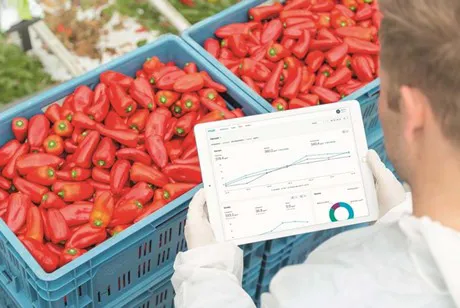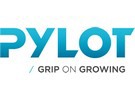 The Pylot data platform was launched at the Greentech. Already 51 greenhouses in 7 countries are working with the system, which was launched by Kubo at GreenTech. Thanks to the platform, growers can actually use the endless flow of information, that can be collected in the greenhouse, in their cultivation. "The information is clearly presented and is usable for the grower or crop advisor," explains Edwin Huybers of Pylot.
The Pylot data platform was launched at the Greentech. Already 51 greenhouses in 7 countries are working with the system, which was launched by Kubo at GreenTech. Thanks to the platform, growers can actually use the endless flow of information, that can be collected in the greenhouse, in their cultivation. "The information is clearly presented and is usable for the grower or crop advisor," explains Edwin Huybers of Pylot.
The goal? "The idea is ultimately to build a system that independently can activate the grower if something goes wrong."
Cultivation is a complex matter. They are also aware of that at Kubo. The greenhouse construction company has projects all over the world. These projects are getting bigger and bigger, while specific cultivation knowledge is not everywhere available. That is why the greenhouse builder decided to get involved in the development of Pylot. With the data platform they want to help growers get the most out of the greenhouse.
"You can also see a greenhouse as half a physics laboratory," says Edwin, who presented the platform at GreenTech this year. “You have to take into account solar radiation, light, humidity, and more. All these indicators are interrelated and are needed to get the plant in the right condition. Applying these processes in a correct manner for a good quality product is a very complex process.”
When reading data, things are sometimes still faltering
"Pylot reads the data from climate computers and other data sources and compiles it into an easy-to-read interface," he continues. “That often goes wrong now: a lot of data is collected in greenhouses, but then you have to be able to read that data in an easy way. A nice graph is of little use if the data points don't mean anything to you, and that can limit the effectiveness of a greenhouse. Pylot provides simple, readable information that makes consideration easier."
There are more data platforms, but these often focus on specific elements from the greenhouse, says Edwin. “With Pylot we focus on trying to give the overall picture. If you want to manage a greenhouse well, you have to approach it from a broad perspective and look at the total overview of all influences.”
“Just imagine that you reach 60 kg / m2 at one location and 65 kg / m2 at the other, how is this possible? Pylot gives you a more concrete insight into the differences between days and the factors that may have led to that. This makes it easier to make good adjustments. ”With Climate Insights, for example, the system indicates whether a day was a good, a green, or a bad, a red day.
Improving
At Pylot, the goal is to gradually develop better results and thus support the learning process of the grower. Thanks to Machine Learning, the system is also better responding to the grower.
The system can be used in new or existing greenhouses. "Pylot connects to the climate computer and other data, such as crop cycles and set points, can be entered manually," says Edwin. “That data, therefore, depends on how the grower wants the greenhouse to function and when which harvest is achieved. Pylot facilitates, so it doesn't matter when it concerns an existing greenhouse. "
Pylot does not make adjustments within the systems, the grower remains leading. He can, therefore, determine what the specific goal is for a company. "Do you want a lower energy consumption with still good quality vegetables, or do you want to grow specifically on high-quality products where consumption makes less of a difference," says Edwin as an example. "You can set up the system for that: The computers learn again from the interventions that you carry out and thus send the appropriate information."
"A little better every day, that's the idea," says Edwin. "Step by step both the grower and the system get better insights into the processes within the greenhouse and which changes need to be implemented to get the best results."
Test greenhouses also participate
After the GreenTech, Pylot received a substantial new customer base. "We are engaged in connecting 51 greenhouses with new users," says Edwin. “The test greenhouses, which have helped with the development over the past two years, have also decided to continue with the system, which of course is great for us. This means that these users experience that they can get the ROI out of the system. It is therefore attractive in terms of price and it is not too complex to use."
The 51 greenhouses are also located in 7 different countries. "We connect new users in the Netherlands, China, South Korea, USA, Kazakhstan, Uzbekistan, and Russia," says Edwin. “In addition, there are also users in Canada who have expressed an interest, and we see that there is interest from Japan, France and Australia. But we must not go too fast, "says Edwin. “There are many startups that come explosively onto the market and get many clients in a short time, but who are not able to deliver the quality. For us, that is above everything else: quality over quantity. We must not promise anything that we cannot deliver. ”
That is also why there is an explicit focus. “We have a theme for Pylot: we have five. We support five types of crops, five climate computers and five languages. The crops are: tomatoes, cucumber, peppers, and recently also eggplant and this month lettuce is on the agenda to be launched. Pylot supports the five largest climate computers and the five languages are: Dutch, English, Russian, French and this fall is the public launch of Chinese. The Asian market is developing rapidly and it is a large country, so the opportunities are huge in China."
In the future
Although it is clear that the emphasis for the use of Pylot is still with the grower himself, that may still change in the future. "Automation is continuing in the market, and Pylot can participate in that in the future," says Edwin. “The ultimate goal for every grower is, of course, a self-controlling greenhouse. With all the information that Pylot is collecting, it will probably be possible in the future to have greenhouse systems that will be controlled by Pylot."
For more information:
KUBO Group
[email protected]
www.kubogroup.nl

Pylot
[email protected]
www.pylot.nl
